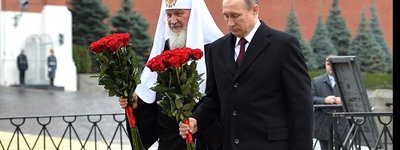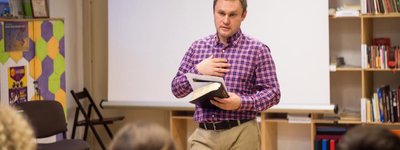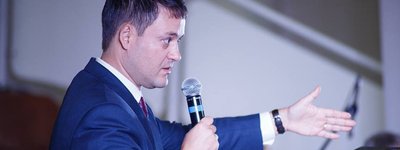Pentecostal and Patriot
The Russian invasion has altered the chemistry of Ukrainian society. Today, it is possible for a Russian-speaking minister of a traditionally apolitical and pacifist church to die fighting for Ukraine.
On December 13, the New York Times’ Andrew E. Kramer reported on Sergei I. Reuta, a Pentecostal pastor who had volunteered for the Dnipro-1 battalion from Dnipropetrovsk (“A Pastor’s Turn Fighting for Ukraine”)
Reuta had spoken Russian all his life and was not a “Ukrainian nationalist.” But after Russian separatists entered his home town and beat up members of his congregation, the 44-year-old minister, who was married with three children, decided to join the thousands of Ukrainian volunteers. “I understood that as a Christian I should defend the land where God put me,” Reuta was quoted as saying. He also saw the Putin regime as an enemy of religious liberty. On November 22, Sergei Reuta was killed in an artillery bombardment at Pisky, near the Donetsk airport.
One does not usually think of Pentecostals as soldiers or patriots. The Pentecostal movement arose in the United States at the end of the nineteenth century out of the “Holiness movement” in the Methodist church. At a revival meeting in Topeka, Kansas in January 1900, the experience of “speaking in tongues” was deemed to be evidence that an individual believer had been baptized by the Holy Spirit. A series of racially integrated revival meetings on Azusa Street in Los Angeles in 1906-1909 was particularly influential. Missionaries fanned out to other nations and continents. In 1911, Pentecostal congregations arose in Helsinki (then in the Russian Empire) and St. Petersburg. Eventually, the American movement split into three main groups. In the 1960s, Pentecostalism influenced the charismatic movement among various Protestant churches and even Catholics. Today, the charismatic movement is particularly strong in Africa and Latin America.
Although the Pentecostal movement was never associated with the Ukrainian nation or identity, during the Soviet era it established a base in Ukraine. The missionary Ivan Voronaev, a former Baptist who had lived in America, entered Ukraine in 1921. By 1926 there were 350 Pentecostal congregations in the Soviet Union, with some 17,000 followers. In Odessa, the All-Ukrainian Council of Christians of the Evangelical Faith began publishing the journal “Evangelist” in 1928. Meanwhile in Volhynia, then under Polish rule, Pentecostal missionary Georgi Schmidt organized a community in Kremenets’. Although the Soviet regime banned the Pentecostal church in 1930, arresting Ivan Voronaev, it soon spread beyond its Ukrainian base to Belarus and Russia. During World War II, the Soviet government, seeing the revival of religion in the German-occupied territories, decided to offer legalization to some religious organizations. In 1944, the All-Union Council of Evangelical Christians-Baptists was formed, and in the following year some 400 Pentecostal congregations joined it. Many congregations, however, found that illegal status was preferable to the restrictions resulting from legal registration, such as the ban on proselytism. The unregistered Pentecostals lived a semi-nomadic life, unable to reconcile Soviet citizenship with their religious principles. A number of young Pentecostal men were imprisoned for refusing military service or the military oath. Premier N.S. Khrushchev’s anti-religious campaign of 1959-1964 further alienated these and other religious believers. (Eugene B. Shirley, Jr. and Michael Rowe, Candle in the Wind: Religion in the Soviet Union, Ethics and Public Policy Center, Washington, DC, 1989, chapter 2).
Pentecostals attracted world attention in the 1960s and 1970s with their attempts to emigrate from the USSR. The cause of the Vashchenko family from Chuguyevka, Siberia was taken up by the British religious liberty research institute, Keston College. (Jenny Robertson, “Be Our Voice,” London, 1984, chapter 7). However, the movement remained strong in Ukraine: it was estimated that more than half the Soviet Union’s Pentecostal congregations were in that republic (William C. Fletcher, “Soviet Believers,” Lawrence, KS 1981, p. 178, citing A.I. Klibanov, “Religioznoe sektantstvo”). In 1985, the West Ukrainian Pentecostal bishop Vasyl’ Boyechko was arrested, and the following year he was sentenced in L’viv to three years in the labor camps. As late as 1987, Keston College listed several Ukrainian Pentecostal prisoners of conscience, including some from L’viv and Dnipropetrovs’k, and from the Transcarpathian, Rivne, Ternopil’ and Donets’k regions. (Keston College, “Religious Prisoners in the USSR,” pp. 112-121). Since independence in 1991, various Pentecostal and other charismatic groups have arisen in Ukraine and the other post-Soviet republics, representing considerable variety in doctrine. (Roman Lunkin, “Traditional Pentecostals in Russia,” East-West Church and Ministry Report, Vol. 12, No. 3, summer 2004)
Today, the example of Pastor Sergei Reuta shows how religious and national life have changed in Ukraine. Like a catalyst, the Russian invasion has altered the chemistry of Ukrainian society. Today, it is possible for a Russian-speaking minister of a traditionally apolitical and pacifist church to die fighting for Ukraine.










